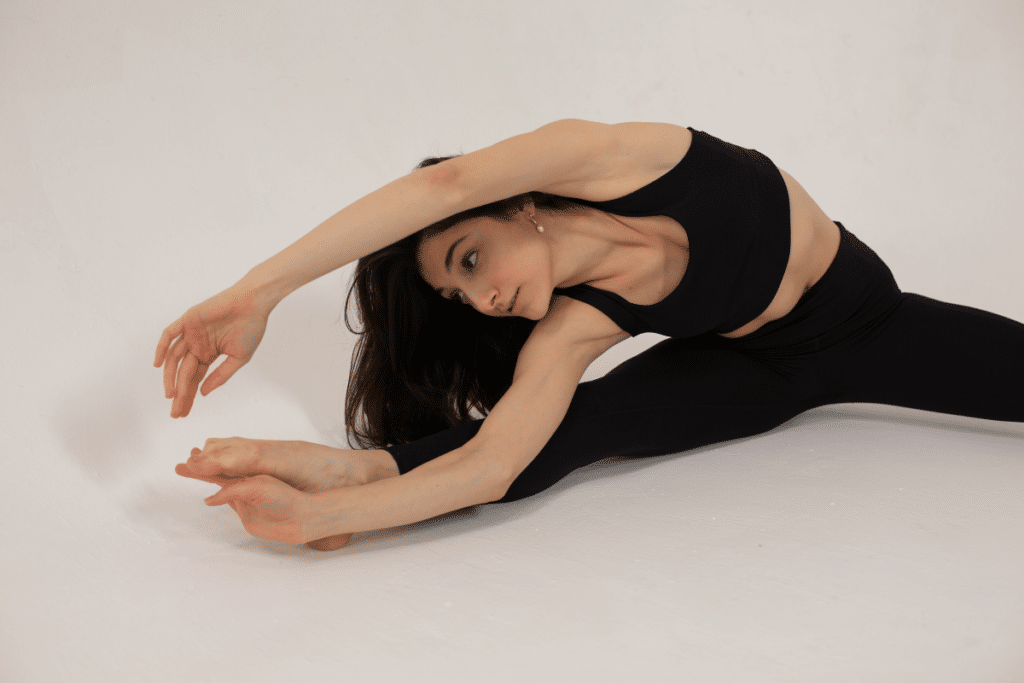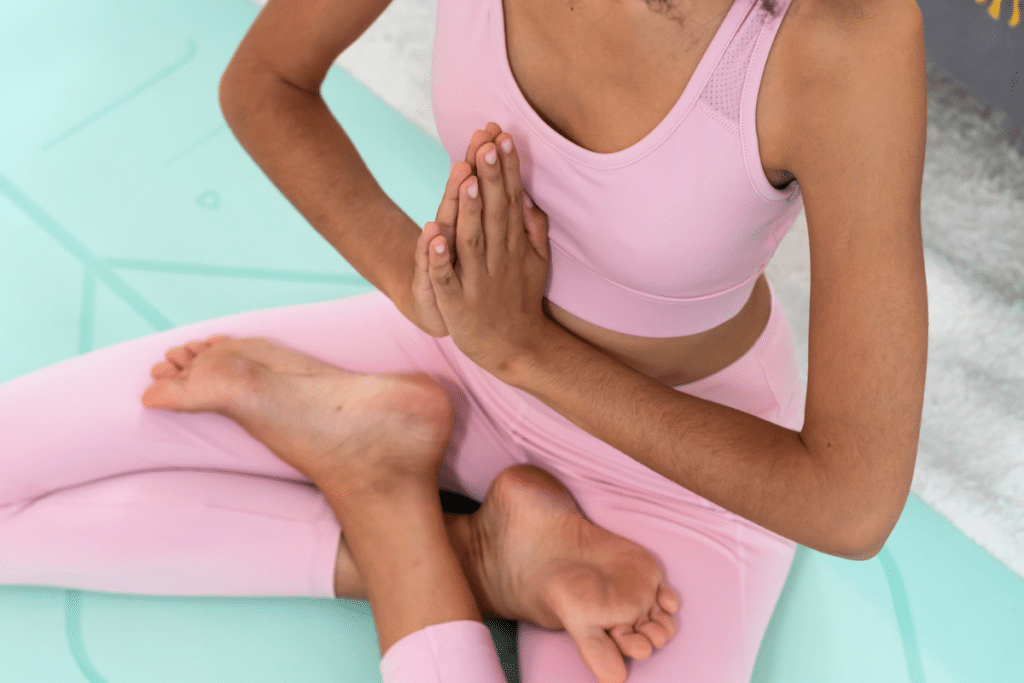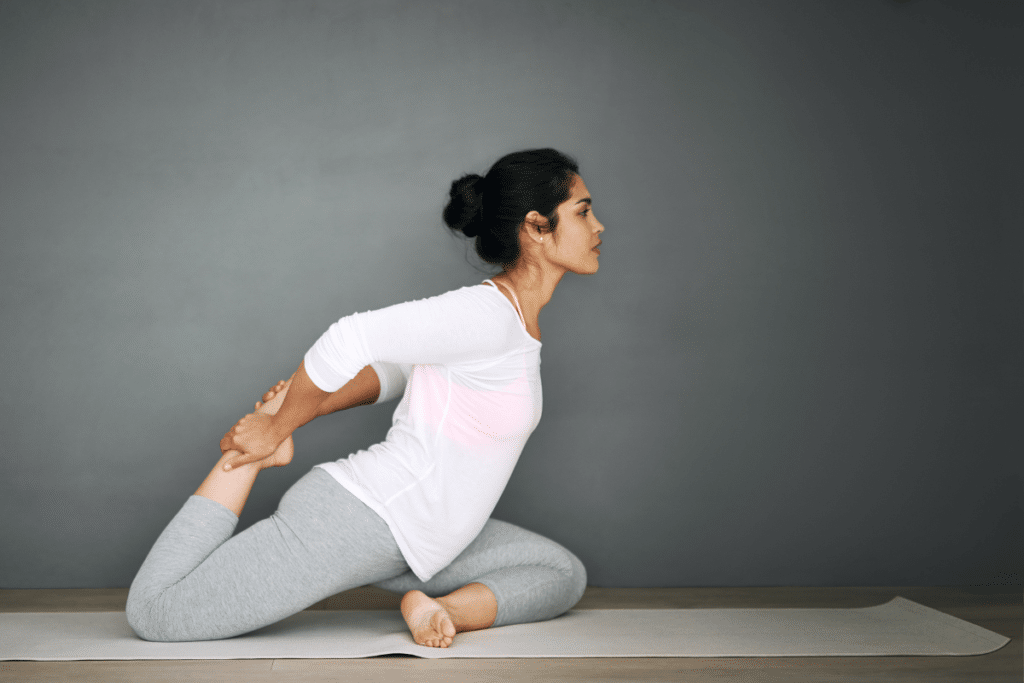How to Increase Flexibility: 6 Hacks for Supercharged Results

Are you looking to increase flexibility in your asana practice? For a lot of people starting out in yoga, flexibility is their number one goal. They want to be able to sit in full lotus, do the splits, or get their head to their shins in a forward fold.
You may be surprised to learn that daily asana practice isn’t the only thing you need to do to increase flexibility in your body, and that physical flexibility is not the only type you should develop. Confused? Worry not, I am going to explain all…
What Do I Mean by Flexibility?
When I hear the word yogi, an image pops into my mind of a sage sitting on a mountain top in full lotus, with a serene look upon his face. I like that image and the way it signifies flexibility, not just of body, but also of mind. It reminds me that there needs to be balance between the physical and the psychological/emotional aspects of myself if I am to find inner peace.
The definition of flexibility according to lexico.com is:
“The quality of bending without breaking.”
This definition relates to the flexibility of an object, and in our case, a body. It means the ability of a physical item to yield to pressure without snapping or becoming damaged. If we think about that for a moment, we can see that the ability to yield to pressure without snapping is just as crucial in life as it is in the physical body.
Another flexibility definition on lexico.com is:
“Willingness to change or compromise.”
Now we are definitely moving into the realm of psychology and life. Possessing a willingness to change or compromise is hugely important if you want to succeed and be happy. What is the alternative? A person who is stuck in their ways, unwilling to see things from other people’s perspectives, and afraid to change and grow.
Why is Flexibility Important in Life?
You can see from the above definitions it is vital to increase flexibility in both body AND mind if we are to grow as a person and experience a full and happy life.
Physical Flexibility
When we increase flexibility of the body, we help ourselves on a physical, mental, emotional, and spiritual level. Physical flexibility is critical in helping us stay supple and active as we age. It helps us to keep moving, reduce physical pain, and remain independent.
Most importantly, having a flexible body means we can sit in meditation for longer periods without becoming uncomfortable. It is this physical discomfort that provides so much distraction during meditation and often prevents us from going deeper within our practice. As you can imagine, this limits our spiritual development greatly and provides much mental and emotional anguish.
In fact, creating comfort for long periods of meditation is the reason the physical asanas were invented in the first place! This point is illustrated in Patanjali’s Eight Limbs of Yoga system.

Mental Flexibility
If we can increase flexibility of mind, we will be able to cope much better with the inevitable stresses and strains of life. The image of the tree comes to mind here. If the tree was totally rigid, it would break in strong winds. For the tree to survive all weather conditions, it needs to be flexible and able to bend without breaking.
It is the same for us humans. We are the tree that must be flexible when the winds of life blow strongly. We must yield to the pressures of life without snapping. If we don’t, we will most likely experience a lot of pain and damage.
Three Ways to Increase Flexibility in the Body
Let’s explore three ways in which you can increase flexibility in your body to help you with your asana practice, reduce pain and stiffness, and enjoy greater comfort during meditation.
1: Practice Yin Yoga
Yin yoga is the best type of yoga to practice if you want to increase flexibility fast. This is because yin yoga targets the deep inner muscles, ligaments, fascia (connective tissue), joints, and bones. It is no good simply working on the superficial muscles and expecting to increase flexibility if these deeper elements are tight and stiff.
Regular ‘yang’ yoga styles move quickly between each posture, and so don’t allow enough time for the asana to really work on stretching the body effectively. It is great for burning calories, toning muscles, and building strength, but not so great if your goal is to increase flexibility.
On the flipside, yin yoga poses are held for between three and ten minutes, which is what’s needed to encourage the stretching and release of tight ligaments, muscles, and fascia. In addition, yin yoga often encourages the use of props.
The benefit of props is that they can make a pose accessible when it may not be without them, and they make the body feel safe and supported. If it does not feel safe, its natural reaction is to tense and tighten to protect against injury. So, by slipping a strategic block under your hip or bolster under your knees, you are encouraging your body to stretch and relax, not limiting its flexibility potential.
Read More: Yin Yoga: 7 Awesome Benefits for Body and Mind
2: Eat More Raw Fruits and Veggies
Bringing more raw fruits and vegetables into your diet has an enormous effect on flexibility. Plants help your body to heal and work properly because they provide nourishment AND reduce inflammation. Inflammation decreases flexibility because it promotes stiffness and it becomes more painful to stretch and move.
Raw fruits and veggies are higher in water than when they’re cooked. Hydration increases tissue malleability and reduces stiffness. Our muscle tissues are 79% water and so they need continuous hydration to remain supple and healthy. Raw plants also aid in the detoxification of waste material due to their water and fiber content. Toxins hugely inhibit flexibility because they increase inflammation.
Also, if you are consuming more raw fruits and veggies in your daily food intake, there will be less space for unhealthy foods such as processed snacks, refined carbs, sugar, and unhealthy fats. All of these foods limit flexibility because they are highly acidic and increase inflammation. Your body is like a car – it needs proper fuel to work efficiently. Put the wrong fuel in and it will cease up.
3: Ditch the Dairy and Gluten
Dairy and gluten are proven to increase mucus production. Mucus can be likened to a stickly glue that gets everywhere inside your body and literally glues it together. Dairy and gluten are also highly acidic foods, and as such will increase inflammation and promote stiffness. If you really want to increase flexibility fast, eliminate all dairy and gluten from your diet. Try it for two weeks, you’ll be amazed at the difference.

Three Ways to Increase Flexibility in the Mind
Here are three ways you can increase flexibility in your mind and your approach to life so that you can bend without breaking. This ability to yield to pressure does not mean that you give up and accept whatever comes your way. On the contrary, that would simply increase the load until you did snap.
Yielding in this sense means to become pliable, malleable, to flow around obstacles like a stream flows around the rocks on the riverbed. When the water meets an obstacle, it finds a way around, over, under, or through. It does not let the obstacle halt its journey. That is what mental flexibility means.
1: Nurture Your Creativity
Developing creativity helps you with problem solving because you are able to find creative solutions and alternative ways around obstacles. Don’t make the mistake of thinking that you are not a creative person and so therefore this cannot apply to you.
That we are either creative OR logical is a myth. While one of these traits can absolutely be more dominant, all humans possess both creativity AND logical thinking. If you feel you lack creativity, then it is even more important for you to nurture and develop this valuable skill.
Developing creativity doesn’t have to mean learning to draw or paint, although those are both excellent creative pursuits if you are drawn to them. If not, think about other creative activities you would like to try. Some examples of creative activities I have enjoyed include:
- Sketching
- Watercolor painting
- Writing poems and stories
- Singing
- Dancing
- Knitting
- Cross-stitch
- Making bath and body products
- Making jewelry
- Cooking
- Making candles
- Scrapbooking and collaging
There are so many ideas for you to try. Why not get involved with the kids or grandkids and build Lego structures or get messy with fingerpaints? If you have no kids in your life, don’t let that stop you from connecting with your inner child. Think of something you loved doing as a kid and rekindle that spark.
Perhaps you enjoyed making finger puppets, crafting pretend perfume out of water and flower petals (I can’t be the only one who did that!), or designing necklaces out of dried and painted penne pasta tubes.
It doesn’t matter what activity you choose, just as long as you enjoy it. If you make time to play and create regularly, your creativity will improve, and you will increase flexibility in your problem-solving skills.
2: Get Out of Your Comfort Zone
The best way to develop resilience and increase flexibility in your attitude to life is to practice being uncomfortable. We know that doing something every day that scares you is good for personal growth, but how many of us actually do it? When we can become friends with discomfort, and consciously seek it out, we are not taken by surprise when it shows up unannounced, as it does so often in life.
Get your journal out and explore some ways in which you can push yourself toward the edge and even a little bit beyond your comfort zone. Maybe you can try an activity that scares you, such as climbing to the top of a really high building if you don’t like heights or making friends with a docile dog if you have cynophobia.
If that feels too much too soon, that’s okay, simply find ways in which you can stretch yourself a little further each day. For example, I am an introvert with anxiety issues, and I find talking on the phone extremely challenging. It is much easier for me to get my husband to make my phone calls for me, and when I am feeling very anxious, he does that for me.
But when I am feeling in a good place mentally and emotionally, I push myself to make calls myself. Now, to some of you reading this my fear of phone conversations might seem silly or childish, but it is actually a legit phobia, called telephonophobia. And for anxious introverts such as myself, it is very real. When I am able to push myself beyond the limits of my comfort zone and make or take calls, I become uncomfortable on purpose. In doing this I increase flexibility in my mind and my ability to handle stress.

3: Meditate Daily
We couldn’t have a conversation about mental flexibility and not discuss meditation. Consciously focusing your mind daily is one of the most effective ways to increase flexibility in the way you to respond to stress.
Notice the use of the word ‘respond.’ Meditation gives you the ability to respond rather than react because it makes space in your mind. In choosing a response rather than reacting habitually, you will be so much more skilful in your interactions with others. You will develop discernment when making decisions, and you will become much less judgmental of others.
You don’t have to start big, and I always advise that you don’t. If you can find five minutes during your day to focus on your breath, then you can begin to develop an effective meditation practice and increase flexibility in your world view and your response to stress.
Read More: 11 Myths About Meditation That Prevent Success
Conclusion
It is as important to increase flexibility of the mind as well as the body. You are a holistic organism and every part is connected – what happens in the body affects the mind and emotions, and vice versa. Try the suggestions above and let us know how you feel by dropping a comment in the box below or connecting with us in our Sacred Circle forum. We would love to hear your thoughts and experiences with developing physical and mental flexibility.







[…] Margo Schaefer April 28, 2023 1 Comment […]
[…] strengthen the body so that they have a clear mind for meditation. They practice asanas so that the body is flexible and comfortable in meditation for extended periods of […]
[…] in order to eliminate distractions and negative mental states. Asana practice prepares the body by making it flexible and minimizing distractions due to pain and discomfort. Pranayama prepares the energy by focusing […]